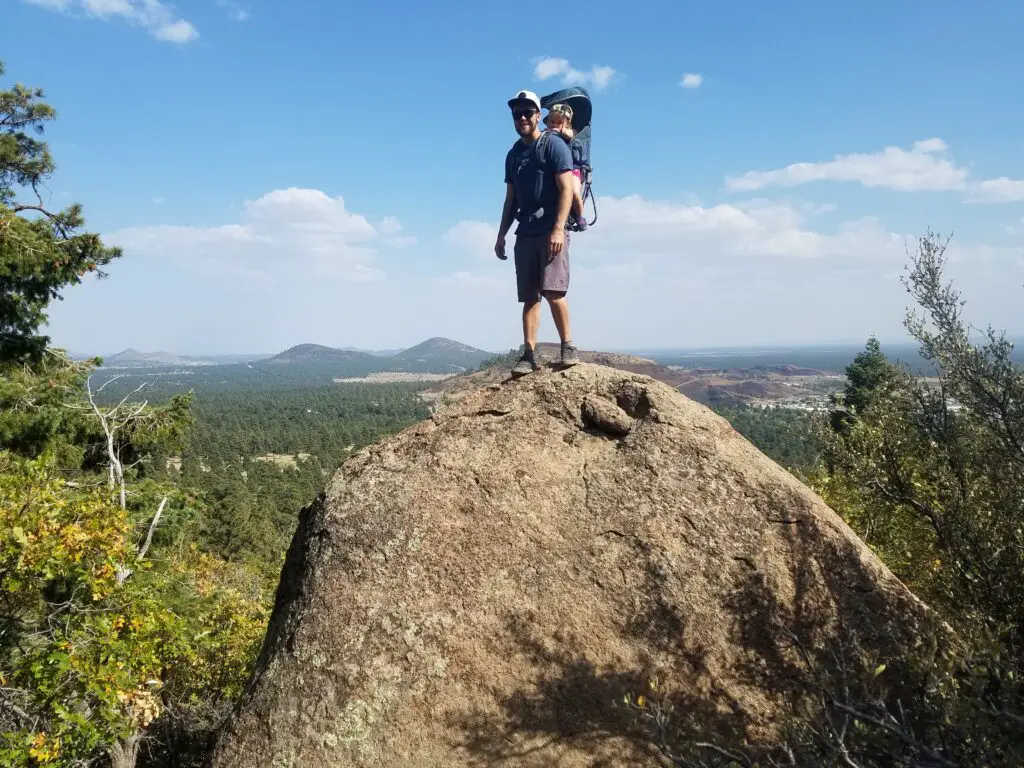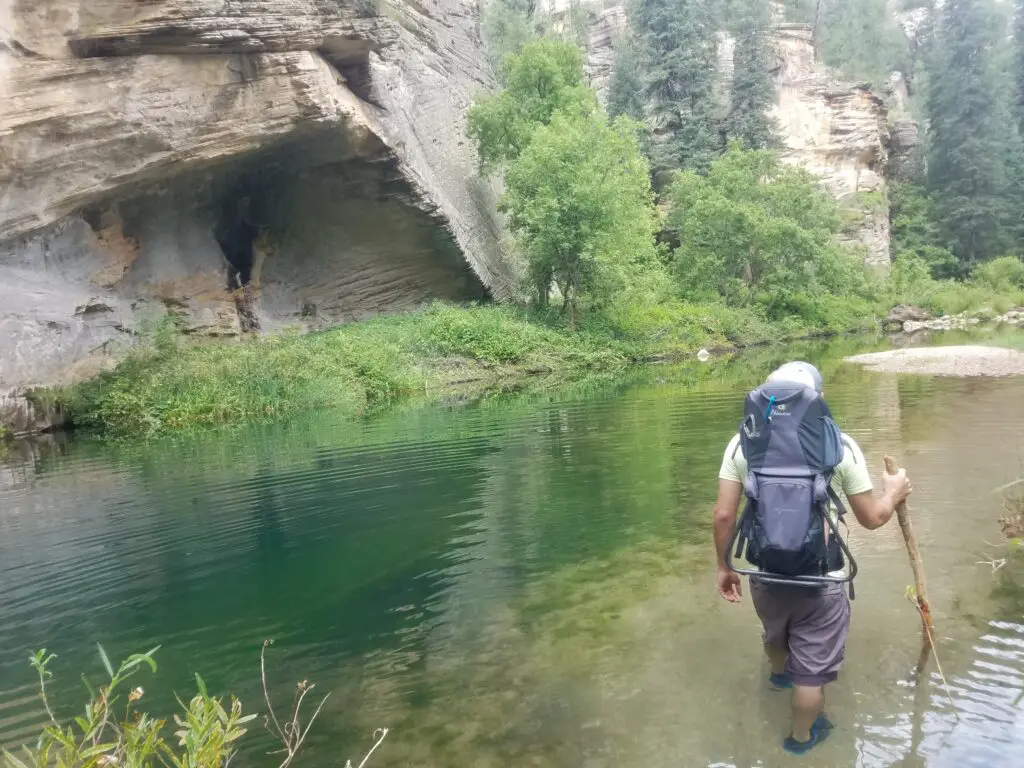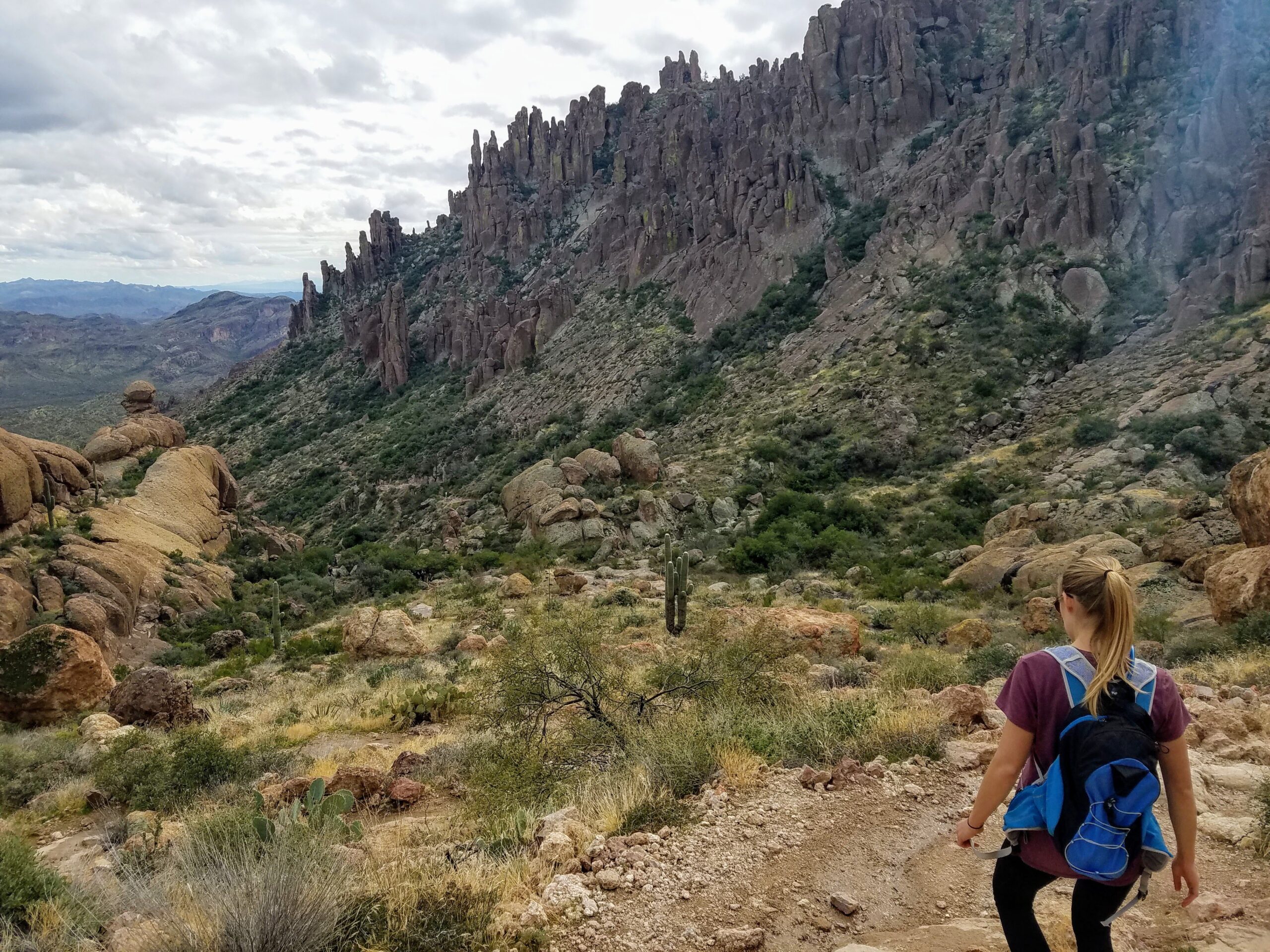Hiking offers incredible views, time with nature, social opportunities and improves overall health and well-being. These, and many other advantages, draw many to create space for this activity in their lives.
Considered an aerobic activity, hiking supports individuals in meeting exercise recommendations of 75 minutes vigorous or 150 minutes moderate aerobic activity per week. What makes hiking an aerobic activity?
Hiking is an aerobic activity because hikers can breathe throughout the exercise and often carry on a conversation with a partner. The oxygen supply that is taken in by the body meets the oxygen demand the body requires due to the physical exertion. Hiking up a steep incline or with a heavy pack can add anaerobic qualities to a hike as well, but hiking is still considered an aerobic activity.
Still confused? The following article will further explain what makes movement aerobic versus anaerobic, benefits of physical activity and specific recommendations.
Anaerobic versus Aerobic
A hike increases heart rate and breathing and consists of prolonged, repetitive movements. These characteristics make this form of movement aerobic or “with oxygen.” As the body works to move oxygen to the active muscles, it improves heart and lung strength.
Anaerobic means “without oxygen” or the demand for oxygen is higher than what the body can supply. Anaerobic activity often increases muscle and bone strength. These are often sprints, weight lifting, and other power activities.
The Talk Test
The “talk” test is simple test to help determine whether an activity is aerobic or anaerobic. The ability to converse with someone during a chosen movement means the body can still use oxygen for energy production. This oxygen use means the activity is aerobic or “with oxygen”.
For example, think about hiking or walking versus sprinting. You can easily breathe and talk throughout most sections of a hike, but if you start sprinting at full speed, there’s no way to carry on a conversation. Your breaths become sharp and short until you’re forced to stop.
Both types of activity are important for a healthy lifestyle, so it’s important to schedule both into your fitness plan. Find activities that qualify as each type of exercise and try them out until you find ones you like.
Benefits of Aerobic Activities Like Hiking
Generally, the lower intensity nature of aerobic activity pushes the body to use a higher ratio of fat to carbohydrate for fuel. These exercises will strengthen the cardiovascular, pulmonary and circulatory system. They also increase muscular endurance and support healthy bones.
Aerobic activities are a good way to lose weight and strengthen the lungs and heart.
Aerobic exercises: running/jogging, walking, cycling, swimming, jump rope, hiking, rock climbing, dancing
See my article What Type of Cardio is Hiking? for more information.
for more information.
Benefits of Anaerobic Activities
When conversation becomes difficult or impossible, this generally indicates anaerobic activity. The high intensity of this activity means the oxygen demand is too high for oxygen supported energy production.
Instead, the body will use other methods of energy production that do not require oxygen. Build-up of metabolites from these alternative processes, such as lactate, prevent longer bouts of anaerobic activity.
The lactic acid is what makes you sore and gives you the ‘pump’ feeling after a strength training session, which helps to build up muscles over time.
Anaerobic movement will require a higher ratio of glucose to fat metabolization for energy. These exercises generally use more calories/energy in a shorter time period. They strengthen muscle, bones and improve overall fitness.
Anaerobic exercises: sprints, weight lifting, high intensity interval training (HIIT)

What Makes Hiking an Excellent Aerobic Activity?
We’ve discussed many of the physical benefits of hiking- it’s an aerobic activity that strengthens your heart and lungs, it helps support weight loss efforts, and strengthens muscles in your legs and core.
Many of these benefits can be gained by walking in a city or on a treadmill though, so what’s so great about hiking?
Nature
The vast majority of people spend less time outside and in nature than they would like. The benefits of exposure to nature are myriad.
The book The Nature Fix walks through the benefits of exposure to nature on each of your five senses- sight, smell, touch, taste, and sound. It can improve mental health and emotional health, as well as the many physiological benefits.
walks through the benefits of exposure to nature on each of your five senses- sight, smell, touch, taste, and sound. It can improve mental health and emotional health, as well as the many physiological benefits.
Just a few minutes of time in a forest or even city park can boost your mood and increase blood flow and brain activity. Your body can reset after a day or two outside and give you a fresh perspective on life.
There are many advantages to walking outside rather than on a treadmill in a gym or basement. These benefits are compounded when that activity is engaged in outside in areas like a forest. Don’t overlook the benefits of nature on your overall health!
Varied Terrain
Walking on a treadmill or on a track or other paved area is certainly good, but the terrain you encounter hiking- even on popular trails- can help in additional ways. Stepping around and over rocks and other obstacles can help strengthen the support muscles and tendons in your legs, as well as engage your core in ways that walking just can’t.
Hiking also engages your mind more as you consider the routes you’ll take and evaluate and analyze each step to ensure you don’t slip and fall due to loose rock or sand or whatever.
Sunlight
It’s the sad truth that most people do not get enough Vitamin D. Unless you work outdoors or spend a significant portion of the day outdoors, you’re unlikely to get adequate Vitamin D.
Often when people do go outside, they slather on so much sunscreen or cover up so much skin that it almost negates the benefits of sunlight exposure. Obviously you don’t want to get sunburned, but there are significant health benefits to getting enough sunlight that shouldn’t be overlooked.
There are many benefits to sunlight that go beyond just vitamin D . Exposure to the sun helps with blood flow and circulation and can reduce blood pressure. According to Researcher Peter Lindqvist, “Avoidance of sun exposure is a risk factor of a similar magnitude as smoking, in terms of life expectancy.” (source
. Exposure to the sun helps with blood flow and circulation and can reduce blood pressure. According to Researcher Peter Lindqvist, “Avoidance of sun exposure is a risk factor of a similar magnitude as smoking, in terms of life expectancy.” (source )
)
Is it Okay to Hike Every Day?
Daily movement will improve overall well-being. However, inadequate rest or consistently performing high impact or high stress activities can negatively impact health. A good exercise regime should incorporate days of lighter activity or active rest between harder workouts.
If summiting a difficult incline on the first day, choose an easy trail or different activity the next day. While some individuals may find their bodies feel fine with hiking every day, continually performing only one form of exercise can result in muscle imbalances and overuse injuries. Switching up the type of activity provides better outcomes than participating in the same activity each day.
Other great cross-training might include weight lifting, yoga, swimming, cycling and pilates. Personal trainers or other healthcare professionals can provide more personalized advice and guidance regarding appropriate levels and types of physical activity.
I’ve written more elsewhere about exercising or working out every day, specifically for teenagers. I think it’s an important topic to hit if it applies to you.
about exercising or working out every day, specifically for teenagers. I think it’s an important topic to hit if it applies to you.
It’s important to get both the aerobic exercise, and the anaerobic. This helps with your endurance and cardiovascular system, as well as your muscular and skeletal systems. It’s important to achieve the right balance for overall fitness.

Benefits of Physical Activity like Hiking
Sometimes burning calories stands out as the sole focus of physical activity. However, daily movement boosts well-being in so many other ways.
First, physical activity remains crucial to healthy body systems such as the pulmonary, cardiovascular and circulatory. It supports a strong heart and lungs. It also improves bone and muscle strength.
Research even suggests that exercise positively impacts gut microbiota. A healthy microbiome improves digestion, the immune system and overall well-being.
One of the biggest pillars of good health is adequate and quality sleep. Guess what helps individuals sleep better? Yep, daily physical activity boosts sleep quality and reduces sleep onset.
Better sleep and physical activity also go hand in hand to reduce chronic inflammation, a significant contributor to disease and poor quality of life.
Additionally, increased physical activity will reduce the risk of cancer, heart disease, diabetes and obesity. It can help control blood sugar and increase insulin sensitivity. Exercise reduces falls in older adults, may improve sexual health and ultimately lengthens life expectancy.
The benefits of incorporating more movement does not stop with protecting physical health. Consistent exercise will also enhance mental and emotional health.
Studies correlate exercise with a release of beneficial hormones and signals such as endorphins, endocannabinoids and dopamine. These neurotransmitters are linked to feelings of pleasure, relaxation and decreased feelings of pain.
Mental clarity comes from the increased flow of oxygen to the brain. Furthermore, movement enhances neuroplasticity, which improves skill learning. These changes sharpen thinking, judgement and learning. And of course, better sleep means better mental and emotional health as well.
Research also links physical activity to better self-confidence and lower stress. In regard to mental health issues, research suggest that physical activity can help those who suffer from anxiety, ADHD, OCD, PTSD and depression.
Highlighting all these benefits can make exercise something to enjoy, rather than just ensure as a punishment for eating a certain amount of food. Find movement that brings pleasure for sustainable results.
Dreading the choice of exercise may indicate a need to try something new. Also, make sure to include physical activity in a way that enhances heath. Too much exercise without adequate rest or practicing extreme measures can result in negative health outcomes.
Physical activity recommendations
Adding even ten minutes of movement daily can improve health. However, current national recommendations encourage adults to incorporate 150 minutes moderate or 75 minutes vigorous activity each week.
This guideline breaks down to about thirty minutes of moderate activity for five days per week. They also suggest adding in at least two muscle strengthening sessions per week.
The guidelines also push adults towards moving more and sitting less. Studies emphasize over and over again the link between sedentary behavior and poor health.
Moving throughout the day improves overall well-being. Finally, experts counsel adults to perform even more than the 150-minute recommendations for additional health benefits or for those hoping to lose weight.
Is aerobic or anaerobic exercise better for weight loss?
Honestly, the type of workout that allows for consistency will best support weight goals. Just as a day of rest does not cause weight gain, neither will one intense workout create instant weight loss.
Weight loss and any other health goal is obtained through a pattern of choices over an extended time period. So, find what activity brings joy and feels good.
Weight loss results from an energy imbalance where output is greater than input. Increasing output or decreasing input will create the needed deficit. Physical activity is part of the equation as heightened movement will burn more energy. A combination of both aerobic and anaerobic exercise will support weight loss.
In regard to energy or calories burned, anaerobic activity tends to burn more calories per minute due to the greater amount of effort required by the movements. However, individuals will find it easier to incorporate longer periods of less intense, aerobic training. This extended time may result in an overall higher number of calories burned from a specific workout session.
Any activity, generally anaerobic, that increases muscle mass will also elevate metabolism. Muscle uses more calories at rest than other body tissue. See my article How Many Calories do you Burn Hiking Versus Walking? for more information.
for more information.
Furthermore, excess post-exercise oxygen consumption (EPOC) heightens with exercises that require more oxygen. This means anaerobic movement will increase the number of calories the body needs at rest after the workout more than aerobic activity.
This section emphasizes the differences in calories required by anaerobic versus aerobic activity. However, good health involves so much more than a certain number on the scale. Balance, along with a variety of activity types, rest and nutrition will optimize health and performance.
Related Questions
Is Hiking an Aerobic Activity? Hiking is considered an aerobic activity because the body is able to bring in as much air as it needs while moving. It can change to anaerobic during really steep sections, which can be identified when the hiker needs to stop to catch their breath. Most hikes are aerobic activity and hikers can carry on a conversation along the trail.
Does Hiking Build Aerobic Capacity? Hiking is a good way to build your aerobic capacity because a person can take on more and more challenging hikes and can adjust their speed as their lungs get stronger. Aerobic capacity expands more quickly at higher altitudes as well.
Can Hiking be Anaerobic? While it’s true that hiking is mostly an aerobic exercise, there are times when it can be considered anaerobic. Hiking can be anaerobic if a hiker is carrying a heavy weight, is moving quickly, or is tackling steep uphill sections. You can tell if an exercise is anaerobic if you’re unable to carry on a conversation throughout and need to stop to catch your breath.

